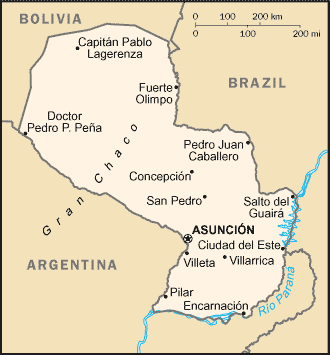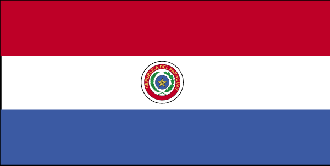
|
Paraguay
Background:
In the disastrous War of the Triple Alliance (1865-70), Paraguay lost
two-thirds of all adult males and much of its territory. It stagnated
economically for the next half century. In the Chaco War of 1932-35, large,
economically important areas were won from Bolivia. The 35-year military
dictatorship of Alfredo Strossner was overthrown in 1989, and, despite a
marked increase in political infighting in recent years, relatively free and
regular presidential elections have been held since then.
Location:
Central South America, northeast of Argentina.
Area: Total: 406,750 sq km, water: 9,450 sq km, land: 397,300 sq km.
Area - comparative: Slightly smaller than California.
Land boundaries: Total: 3,920 km, border countries: Argentina 1,880 km,
Bolivia 750 km, Brazil 1,290 km.
Coastline: 0 km (landlocked).
Climate and Terrain:
Climate: Subtropical to temperate; substantial rainfall in the eastern
portions, becoming semiarid in the far west.
Terrain: Grassy plains and wooded hills east of Rio Paraguay; Gran Chaco region
west of Rio Paraguay mostly low, marshy plain near the river, and dry forest
and thorny scrub elsewhere.
People:
Population: 6,036,900.
Ethnic groups: Mestizo (mixed Spanish and Amerindian) 95%.
Religions: Roman Catholic 90%, Mennonite, and other Protestant.
Languages: Spanish (official), Guarani (official).
Government:
Government type: Constitutional republic.
Capital: Asuncion.
Independence: 14 May 1811 (from Spain).
Economy overview:
Paraguay has a market economy marked by a large informal sector. The informal
sector features both re-export of imported consumer goods to neighboring
countries as well as the activities of thousands of micro-enterprises and urban
street vendors. Because of the importance of the informal sector, accurate
economic measures are difficult to obtain. A large percentage of the population
derives their living from agricultural activity, often on a subsistence basis.
The formal economy grew by an average of about 3% annually in 1995-97; but GDP
declined slightly in 1998, 1999, and 2000, rose slightly in 2001, only to fall
again in 2002.
Statistics:
Telephones - main lines in use: 290,475.
Telephones - mobile cellular: 510,000.
Radio broadcast stations: AM 46, FM 27, shortwave 6.
Radios: 925,000.
Television broadcast stations: 4.
Televisions: 990,000.
Internet users: 20,000.
Railways: Total: 441 km.
Highways: Total: 25,901 km, paved: 3,067 km, unpaved: 22,834 km.
Airports: 879, with paved runways: 11, with unpaved runways: 868.
Return to Visiting Locations
|

